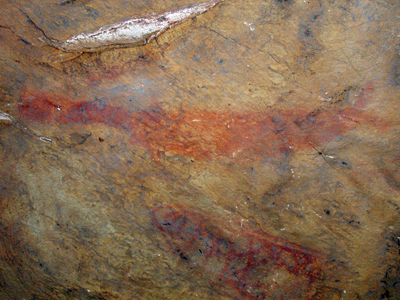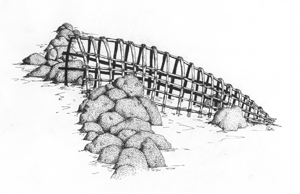|
Fish-trap and Paddlefish
By Deborah Sabo In rock art research a panel is the term for an area where more than one pictograph or petroglyph exist in close proximity. There may be two or hundreds of images in a panel. Some panels also have the character of a “scene,” in which two or more rock art images seem to relate to each other thematically, creating a little narrative. A very striking example of this is the fish trap and paddlefish panel on Petit Jean Mountain. These large red-painted pictographs are naturalistic, in the sense that they are easily recognizable, portraying their subject matter in lifelike form.
Another name for the paddlefish (Polyodon spathula) is spoonbill catfish. These fish have no scales. They are distinguished by a long paddle-shaped snout and a bifurcated tail. In Arkansas the average paddlefish grows to about three feet long and weighs a bit less than 25 pounds. They like to move in shallow water and slow currents, where they feed by filtering tiny zooplankton across comb-like structures on their gills. The paddlefish pictograph is life-sized, just about a yard long (104 cm) from snout to tail. It is entirely filled in with red paint and very accurately shows the fish’s shape as if you were standing on a riverbank looking down into the shallows, or perhaps from a canoe. You see the fish “top down,” so the strong dorsal fin on the fish’s back is not drawn on the pictograph; however, the smaller ventral and anal fins on the sides are drawn, and the bifurcated (double-lobed) tail is clearly drawn. Of course, the long spatula-like snout is the most dramatic feature.
Just below is the fish-trap pictograph. This one would perhaps have been a little harder to identify if it had been all by itself. But since it was painted so close to the fish image, its resemblance to examples of fish-traps known from many cultures was recognized. These traps are large and cone-shaped, made of twigs, reeds, or bark using loose-weave basketry techniques. The fish enters at the wider opening and cannot get out. This type of fish-trap was widely used along with a weir. Weirs are stone or wood constructions built across a stream as a barrier to guide the fish into the traps. We don’t have any prehistoric examples of fish-traps from sites in Arkansas, but we do have preserved remains of fishnets and many styles of weaving and basketry, showing that Indians from the Archaic period and later knew the techniques to make and use a fish-trap like this one. It’s also interesting to notice that because of the slow-moving waters preferred by paddlefish, traps set in weirs would be a good way to catch them. Why did someone make these painted images? Archeologists are not sure if such expressions were meant to tell a story of something that happened (“we caught a big paddlefish today”) or something they hope will happen (“if we draw this event today it is more likely to happen tomorrow”). The paddlefish and fish-trap panel is at a site near the Petit Jean River and the Arkansas River. There are no fish bones at the site, but fish bones are very delicate and are rarely preserved. Other archeological evidence shows that fish were important to the Indian people living in the Central Arkansas River Valley, as a food source and as symbols in art. |

